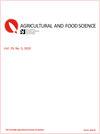饲料能量和蛋白质水平对长毛后期蓝狐生长和毛皮参数的影响
IF 1.1
4区 农林科学
Q3 AGRICULTURE, MULTIDISCIPLINARY
引用次数: 0
摘要
本研究的目的是确定饲料能量含量的降低是否会在不影响毛皮质量或毛皮尺寸的情况下,阻止生长-蜕皮后期蓝狐的极端体重增加和肥胖。从10月中旬开始至脱皮(50 d),将60只蓝狐分为4个大小相同的组,研究了体重增重、体重指数(BMI)、身体状况评分(BCS)和毛皮特征。实验饮食分为“高能量-高蛋白”、“高能量-低蛋白”、“低能量-高蛋白”和“低能量-低蛋白”。高能饲粮的干物质代谢能(ME)为19.3 MJ / kg,高蛋白饲粮的可消化粗蛋白质(DCP)为ME的20%。低能量饲粮的代谢能为16.3 MJ / kg DM,低蛋白质饲粮的代谢能为17% / kg DM。饲喂量逐渐增加,趋于随意。减少代谢能摄入量对毛皮大小和毛皮质量没有影响。高能饲料导致动物体重增加,身体质量指数也更高。但各组最终体重均超过20 kg, BCS均为“肥胖”或“极胖”。本文章由计算机程序翻译,如有差异,请以英文原文为准。
Effects of feed energy and protein level on growth and pelt parameters in blue foxes (Vulpes lagopus) in the late growing-furring period
The aim of the present study was to determine whether a decrease in feed energy content would prevent extreme body weight (BW) gain and fatness in blue foxes in the late growing-furring period, without compromising pelt quality or pelt size. BW gain, body mass index (BMI), body condition score (BCS), and pelt characteristics were studied in 60 blue foxes divided into four equal-sized groups from mid-October until pelting (50 days). Experimental diets in were “high energy – high protein”, “high energy – low protein”, “low energy – high protein”, and “low energy – low protein”. High-energy diets contained 19.3 MJ metabolisable energy (ME) in kg dry matter (DM) and high-protein diets contained digestible crude protein (DCP) 20% of ME. Low-energy diets contained 16.3 MJ ME in kg DM and low-protein diets DCP 17% of ME. Feeding was gradually increased towards ad libitum. Reduced ME intake had no effect on pelt size or pelt quality. High-energy feeds resulted in heavier animals with higher BMI. However, the final BW exceeded 20 kg and BCS was “fat” or “extremely fat” in all groups.
求助全文
通过发布文献求助,成功后即可免费获取论文全文。
去求助
来源期刊

Agricultural and Food Science
农林科学-农业综合
CiteScore
2.50
自引率
0.00%
发文量
22
审稿时长
>36 weeks
期刊介绍:
Agricultural and Food Science (AFSci) publishes original research reports on agriculture and food research related to primary production and which have a northern dimension. The fields within the scope of the journal include agricultural economics, agricultural engineering, animal science, environmental science, horticulture, plant and soil science and primary production-related food science. Papers covering both basic and applied research are welcome.
AFSci is published by the Scientific Agricultural Society of Finland. AFSci, former The Journal of the Scientific Agricultural Society of Finland, has been published regularly since 1928. Alongside the printed version, online publishing began in 2000. Since the year 2010 Agricultural and Food Science has only been available online as an Open Access journal, provided to the user free of charge. Full texts are available online from 1945 on.
 求助内容:
求助内容: 应助结果提醒方式:
应助结果提醒方式:


